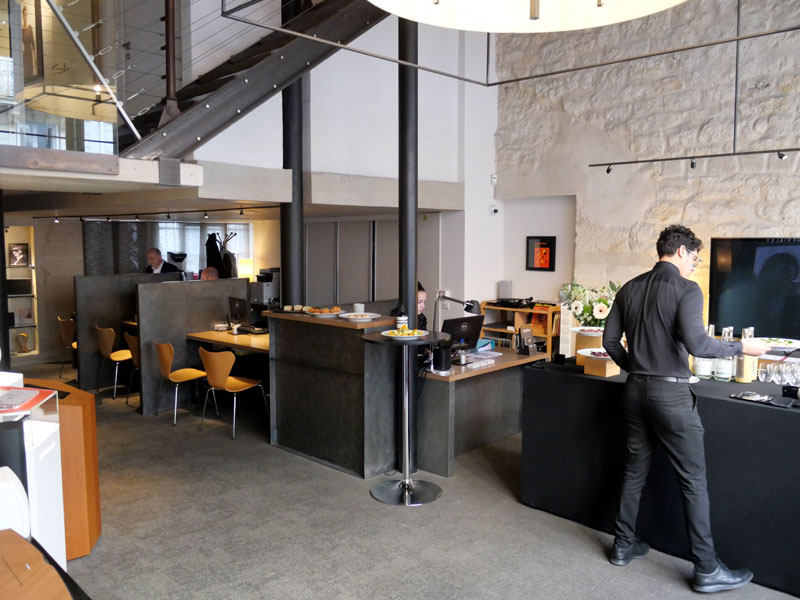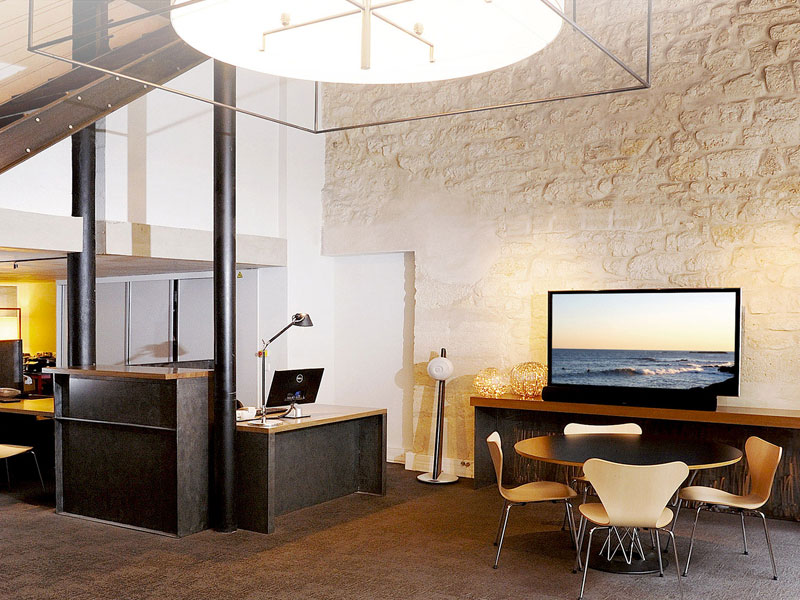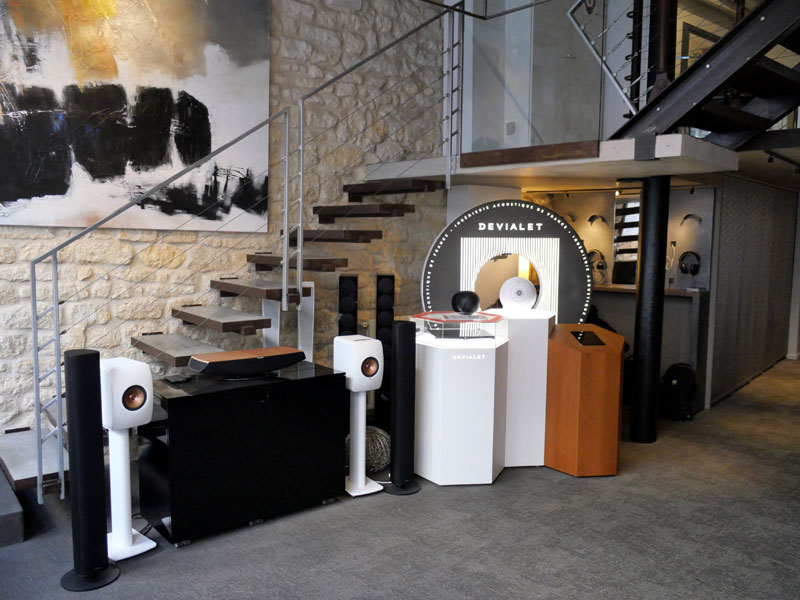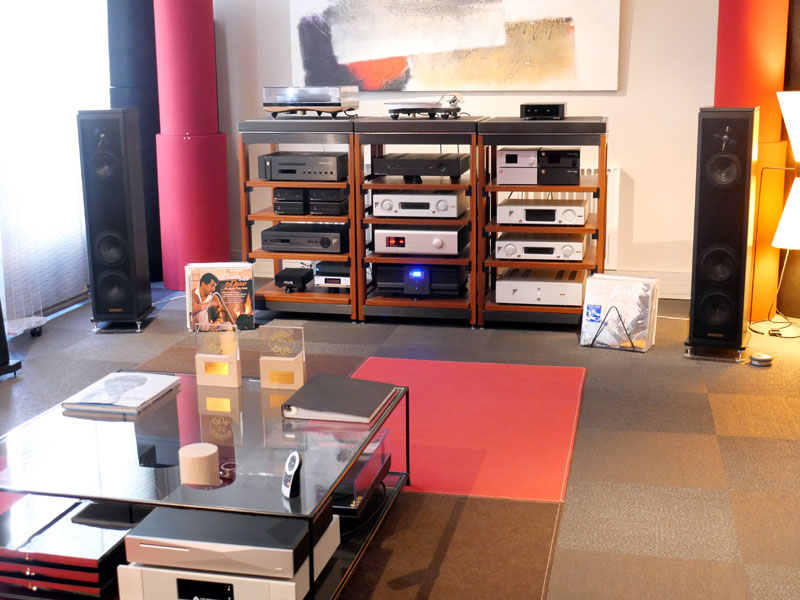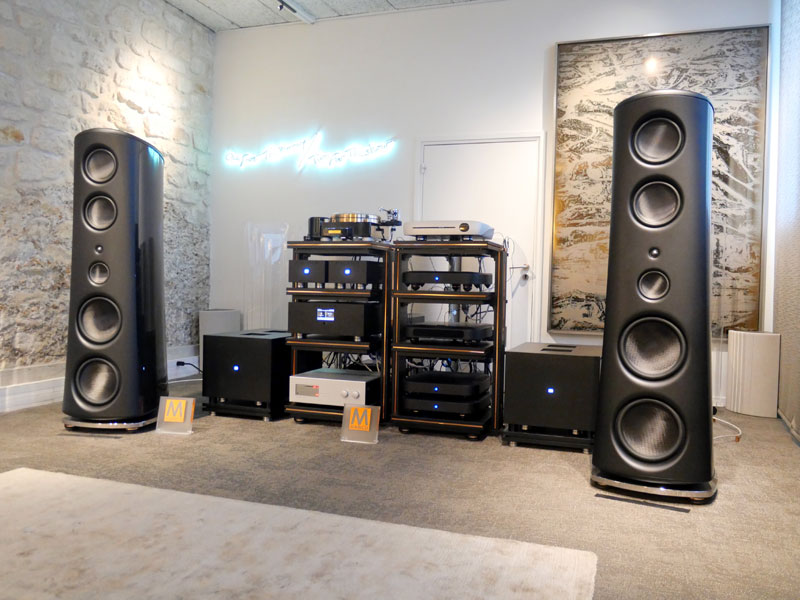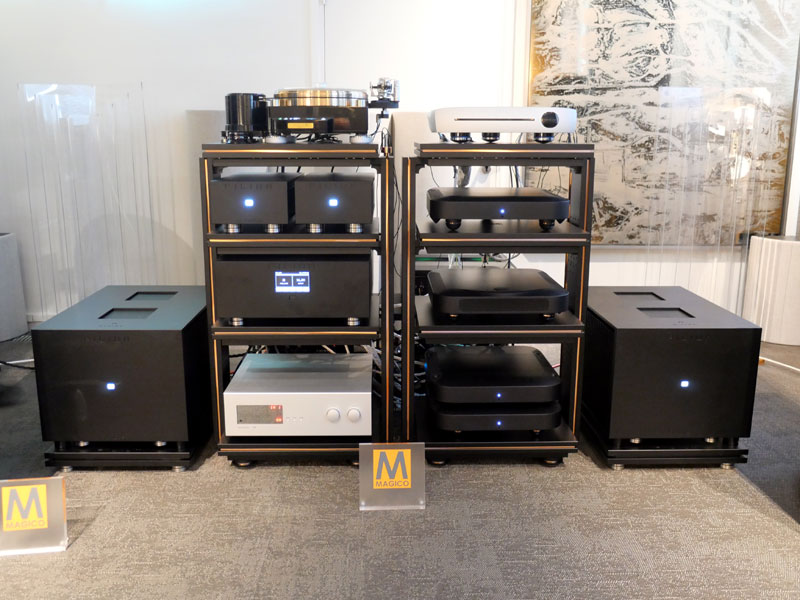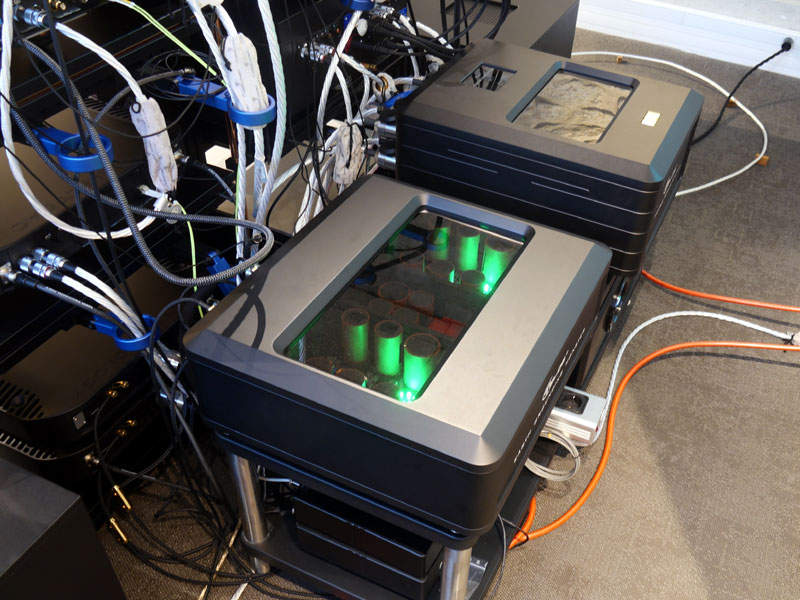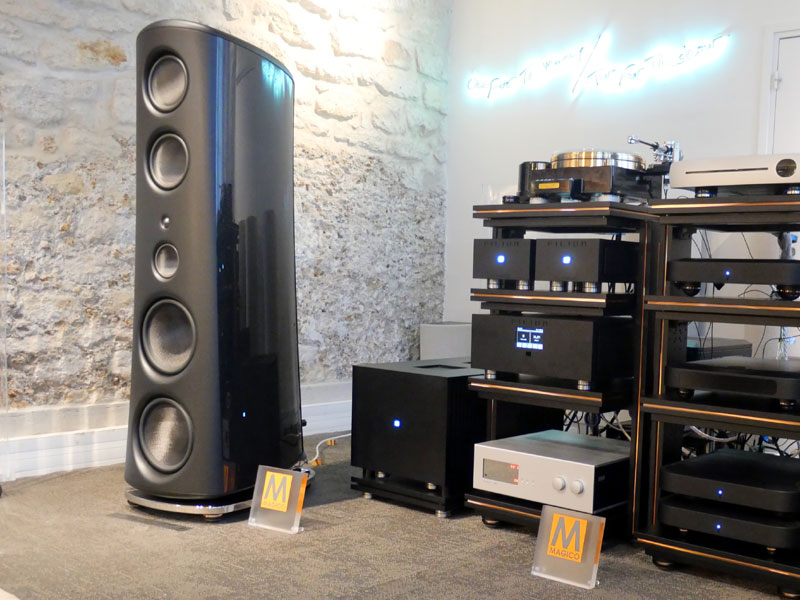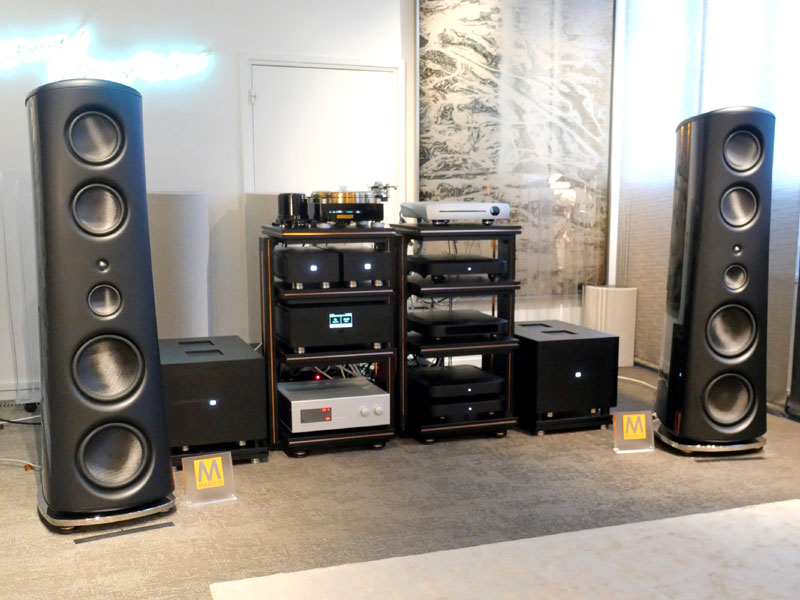On the Runway in Paris: Présence Audio Conseil Debuts the Magico
M7
t’s not exactly usual for a major US manufacturer to launch a significant new product at a dealer’s store. It’s definitely not usual for that store to be outside the US, or for the launch to be a standalone event, rather than an outlier attached to a major show. In fact, any way you cut it, Magico’s M7 launch event was anything but normal -- but then Présence Audio Conseil in Paris is anything but your average dealer.
You’ll find Présence Audio at 10 Rue des Filles du Calvaire, not a hundred meters from the Metro station of the same name, located at the northern end of the chi-chi Marais district, renowned for its vibrant atmosphere, and myriad eateries, arts ateliers and up-and-coming fashion stores. It's loosely bordered on one side by Boulevard Voltaire and the Bataclan Theatre, and on the other by the exoskeletal Centre Pompidou. It offers performance art, modern art and everything in between. But this is not simply an audio store, which helps explain why Magico brought its latest (and second biggest) baby here. In an arrangement that is becoming increasingly common, Présence Audio Conseil acts as both the showroom and a retail outlet for Magico’s French distributor Sound&Colors, headed by the urbane and quintessentially Parisian Guy Boselli. A major force in the French audio market, Sound&Colors (founded in 2006) represents some serious hardware, including the likes of Antipodes Audio, Ayre, Constellation, Critical Mass, Crystal Cable, Kharma, MSB, Pilium, Soulution, TechDAS and Wadax. And when I say “represents,” I mean more than in name only. This is a distributor that actually carries the full Wadax Reference line, everything offered by Constellation, Pilium and Solution, the full MSB stack. But alongside those big-ticket items you’ll also find the likes of Rega, Gold Note and Cyrus -- high-performance, affordable audio products that you’ll find on many a dealer’s shelves. Which brings us straight to the nub of the problem -- the challenge facing any distributor in today’s high-end-audio market. These days, dealer-distributors are thick on the ground. With so many high-end brands vying for attention, why wouldn’t a dealer pick up a couple of interesting lines to distribute -- even if that distribution only extends as far as his front door? He get’s to offer something that nobody else has and he gets to buy it in at the much lower distributor, rather than dealer, price, so he either makes more money or has more room to discount. It’s a situation that confronts established distributors with a serious problem, a problem that is compounded by the rising price of high-end components and the paucity of investment available from dealers. Increasingly, major distributors are turning to a hybrid (or asymmetric) business model -- and Présence Audio Conseil, which Sound&Colors acquired in 2013, is one of the nicest and most refined examples I’ve seen.
The store occupies the first three floors of a typically low Parisian apartment block, but forget any ideas you might have of 19th-century Haussmann elegance. From the massive, darkly framed windows of the storefront, to its open reception area, the store is clean and resolutely modern, decorated in gallery shades and large, mainly photographic artworks. It’s as striking as it is classy.
Conseil translates as council, and the first thing that strikes you on entering the store is the row of desks down the right side. These are individual customer-service points that underline the consultative nature of the process. This isn’t a store where you just drop in for a quick listen.
On the left, an open-plan staircase leads up to the mezzanine, with its offices and meeting room, and on up to the second floor, where you’ll find three dedicated listening rooms, hosting a wide range of equipment, sourced from distributor Sound&Colors as well as other manufacturers and distributors.
Behind the reception area is a fourth larger demonstration studio, and it’s here that the Magico M7s have been installed, along with a suitably impressive system to drive them. The presence of flagship products from MSB and Pilium helps underline the dual nature of the store -- part retail outlet, part showroom. Capable of supplying anything from a Rega/Cyrus/B&W system all the way up to some of the most expensive audio components on the planet, Présence Audio Conseil is simultaneously a conventional retail outlet and a location where potential customers can experience products that regional dealers simply cannot afford to stock.
The Magico line is a perfect case in point. While Sound&Colors can boast over a hundred dealers, only nine of those list the American speaker brand -- and one of those is Présence and another is in Antibes. Now, ask yourself, which speakers those other dealers stock. The answer is going to be mainly A-series and a few S-series. A couple might have an M-series model, but in all cases it will be predominantly the smaller speakers in each line. If you want to hear the M6, let alone the M7, then it is up to Sound&Colors to provide the opportunity. On the one hand, that presents a tricky tightrope for any distributor to walk. Can they expect dealer loyalty if customers can buy direct from them? In the end, it comes down to trust and the individuals involved. But one thing is for sure -- it’s not a situation that’s going away, and dealers will need to adapt to it, accommodate it or come up with some credible alternative if they want to stay relevant.
On the other hand, it also helps explain how Magico ended up launching the M7 at a Parisian dealer. As I said -- this is no ordinary dealer. Walk into that demonstration studio and the first thing that strikes you is not just the speakers but the driving system too. It’s quite a collection: Magico M7 speakers (around €500,000/pair), Antipodes Audio Oladra server/streamer (€34,000), MSB Select DAC and Digital Director (€166,000 total), Pilium Olympus preamp (€68,000), Pilium Atlas mono amps (€176,000/pair). If you want to play records, you can add a TechDAS AirForce III Premium turntable (€35,000), with Graham Phantom Elite tonearm (€15,000) and TechDAS TCD-01Ti cartridge (€9900), and a Soulution 755 phono stage (€62,000).
Then there’s the full set of Crystal Cable DaVinci interconnects, speaker cables and power cords. The Telos Silver Grounding Monster (€72,000) a prototype of the Power Monster, Magico M-racks and more Q-pods and Centre-Stage footers than you can count in a single glance. Add that lot up and it comes to a seriously substantial bottom line: greater than €900,000 for a single-source system, plus the cables, power/grounding components, supports and ancillaries. It’s also exactly the sort of set up we’ve seen Magico use many times at shows, involving many of the same brands. But the key point is that it’s all already here; and not just that -- it’s all in a properly voiced listening room with solid walls and a solid AC supply. Sure, you could turn up with this system in Munich for the High End show, but you’d have to provide or source all of the components, ship them and set the system up in short order, and you wouldn’t be doing it in a proper listening room. Put like that, the decision to bring the M7s to Paris looks like a no-brainer, financially and in terms of the end result -- especially if they’re going to stay there.
Launching the M7 in Paris does have a certain je ne sais quoi, but the event clearly needs to deliver too -- both in terms of sonic results and market profile. Magico is in the fortunate situation of having a loyal customer base and has been established long enough to have its own well-developed communications channels. Where once a company would have invited magazines to a launch and then relied on those publications to spread the word, these days the manufacturers just need the copy, and they can disseminate it themselves. A quick trawl across the various audio fora and websites demonstrates just how successfully Magico has achieved that goal. Even so, don’t be surprised if a similar event occurs in the US, either at a dealer’s store or at Magico’s own listening facility in the Bay Area. As to the sonic benefits of the approach, a few hours at an event like this trump any show experience -- ever. The Présence Audio event certainly allowed not just the M7 to strut its stuff, it allowed listeners to get a far more accurate sense of just what the speaker does, where it stands and what it represents in terms of Magico’s product line. You’ll find the roots of the M7 in the then-distinctive shape of the limited-edition M-Project, the first Magico speaker to introduce a curved wall, carbon-fiber, monocoque enclosure. That led directly to the three-way M6 ($172,000/pair) and then a collection of smaller M models, all featuring the same boat-back form factor. Meanwhile, at the other end of the M series, Magico was working on a new flagship design, a huge and hugely ambitious, multi-driver, four-way, part-active model that appeared as the M9. As is the way with such things, the M9 is a challenge on every level, but especially practically (it is genuinely enormous and seriously heavy) and financially (at $750,000/pair, it is also ruinously expensive). The M7 fits neatly between the M6 and the M9, adopting many of the latter’s salient features in a far more manageable and rather more affordable package. It shares the four-way, six-driver topology of the flagship but somewhat scaled down. Where the M9 stands 80” tall and boasts paired 15” bass and 11” midbass drivers, the M7 is a mere 65” tall, with two 12” bass drivers and two 9” mid-bass units. It also shares the double curvature to its carbon-fiber-walled enclosure, the same midrange and treble drivers, the same essential, slightly waisted styling, and the same polished plinth. Naturally, all the bass and midrange drivers use Magico’s proprietary graphene/carbon-skinned, aluminum-honeycomb-sandwich diaphragms, while the tweeter dome is diamond-coated beryllium. What the M7 doesn’t have is active amplification of its bottom end, it being a conventional, passive, four-way sealed box. Put all that together and you have a speaker that is roughly the size of an Wilson Alexx V or Göbel Divin Noblesse, but whose softly curved extremities make it significantly less visually intrusive than either. At a US list of $375,000, it is half the price of the M9, although if that number causes a double-take against the roughly €500,000 European pricing, just remember that in France or anywhere else in the EU, the retail price reflects shipping costs, duty and 20% sales tax. You do the math, although the apparently nice, round number attached to the M7’s European price tag is yet to be settled, given the current instability in the US dollar/Euro exchange rate. I’ve been waiting for the M7 with some considerable anticipation. Although I have plenty of experience with large Magicos, for all their admirable qualities, the speakers have never managed to seduce me. That started to change with the M-Project and continued with the M6. Looking at the developmental path taken by the M9, especially as regards the much more sophisticated enclosure, with its bidirectional curvature adding serious stiffness and mechanical control. Like other major manufacturers, Magico has invested heavily in measurement and diagnostic hardware, allowing them to pursue their aims when it comes to both drivers and cabinets much more effectively. I was expecting a step-change in musical performance for the M7, and I wasn’t disappointed. The two things were immediately apparent: the M7 is definitely a Magico and it is missing something I don't miss. As with other Magico speakers I've heard, the clarity and low-frequency resolution of the M7 might give the impression of reticence (partly because the impact of bass weight spreads up as well as down), but the speaker’s ability to separate instruments and lines, to reveal who is playing what and when -- and to do so utterly effortlessly -- bring a natural sense of scale and perspective to the performance, which is just as engaging in its own way as the excited thump you get from most of the competition. Following this point, after living for an extended period with the often slightly muddled enthusiasm that characterizes the bottom end of so many reflex-loaded speakers, that rounded hump that adds weight and energy where it would otherwise be lacking, I found that the sheer linearity and gentle roll-off of the M7’s infinite-baffle loading comes as both a surprise and something of a revelation. Like sugar in your coffee, you miss that reflex bump if it’s not there. But also like sugar in your coffee, it hides whole layers of information and texture. Given the M7’s exemplary lack of additive coloration, it would be easy to conclude that any perceived thinness or lack of weight is down to subtractive effects, but listening to acoustic instruments with the M7, I think it’s more a case of familiarity breeding expectation. The M7 isn’t thin, nor does it flatter to deceive. The bass might not draw undue attention to itself, but it’s definitely there when necessary. A particularly telling example is the way in which the system was able to preserve the shape, body, weight (yes, weight) and vibrant complexity of the harpsichord on original-instruments recordings. So often reduced to a vaguely irritating jangle, somewhere in the orchestral background, here the instrument’s size and presence were palpable, the lively nature of this hollow box laced with tensioned strings unmistakable. But more importantly, its musical raison d’ętre was laid bare. If you ever wondered why baroque composers persisted with the harpsichord continuo, the M7 certainly answers that question. Even better, it keeps the instrument’s layered and textured bottom end completely distinct from bowed cello and double bass, the latter, in particular, producing wonderfully woody tones that float across the stage rather than flopping onto it. This is by some distance the most informative and transparent bottom end I’ve heard from a Magico speaker. and, in turn, that informs the balance, clarity, shape and proportions of the rest of the range. The absence of intrusive cabinet artifacts also aids the top-to-bottom continuity of the speaker. It’s natural to assume that system integration is largely a function of the crossover, but discontinuities or irregularities can easily be generated by a misbehaving enclosure or poor dispersion. The rigidity of the carbon-fiber shell and the carefully curved and sculpted baffle combine with the material continuity in the drivers to generate a genuinely seamless sound that is utterly divorced from the cabinets themselves. Shut your eyes and these speakers disappear. Play piano and, again, the scale, weight and presence of the instrument, the complexity, length and decay of the chords, are reproduced with effortless clarity and resolution. But perhaps most important of all, the even balance, the lack of additive energy or subtractive holes in the musical fabric, bring a sense of natural musical energy, progression and dynamic coherence, linked to a greater sense of vocal and instrumental agility and more natural musical articulation. All that matters because those are the very qualities I’ve always found lacking in previous Magicos. They’ve always possessed the detail and resolution, but have seemingly struggled to join the dots. A lot of that is, I suspect, down to a newfound sense of dynamic freedom, an ability to resolve both micro- and macrodynamics that reflects instrumental textures and the character of the harpsichord, the distinct tonality of multiple, violins or voices, the subtle dynamic gradation in an ascending musical climax. The M7 tracks the signal’s dynamic demands without hesitation -- as long as there’s no hesitation in the signal. One consideration here is the impedance/drive characteristics of the speaker -- and the amplifier’s ability to meet those demands. The M7 doesn’t sound like it’s an awkward load, but looking at the humungous bulk of the Pilium Atlas monoblocks (I’m used to moving/positioning heavy amps, but these probably feel like they’re bolted to the floor), I was minded to inquire as to just how difficult the M7s are to drive. The answer was predictably coy: a 4-ohm load with no nasty dips or corners and a sensitivity of 91dB. Okay, I get that everybody thinks their baby is beautiful and these are not published specs, but the overriding impression I got was that the M7 is not that difficult a load and is actually easier to drive than some of its brethren. Time will tell, but for the moment, this speaker certainly seems more responsive to input than other Magicos I’ve heard.
Given that the Magico M7 is, like every other loudspeaker, a transducer, and given that transducers involve higher distortion levels than other components in the chain, this level of insight into system performance is genuinely remarkable. I suspect I’ve barely scraped the surface of what the M7 can do. I’ve yet to discover the limits of its performance envelope. But I got a lot closer and learned an awful lot more as a result of hearing the speaker at Présence Audio Conseil than in some anonymous hotel room. The experience engendered considerable respect for the M7 -- and a desire to spend more time with this revealing and self-effacing loudspeaker. It left me grateful that Magico stepped off the well-trodden high-end path when it came to launching what is a vitally important product for the company. I’m glad that Sound&Colors was willing to accept both the kudos and the challenge of such a high-profile event -- and was able to rise to that challenge. The conclusion is inescapable: it’s going to be
worth my while to revisit both Présence Audio Conseil and the Magico M7. If you happen to
be in Paris, I’m confident you’d enjoy doing the same. |


